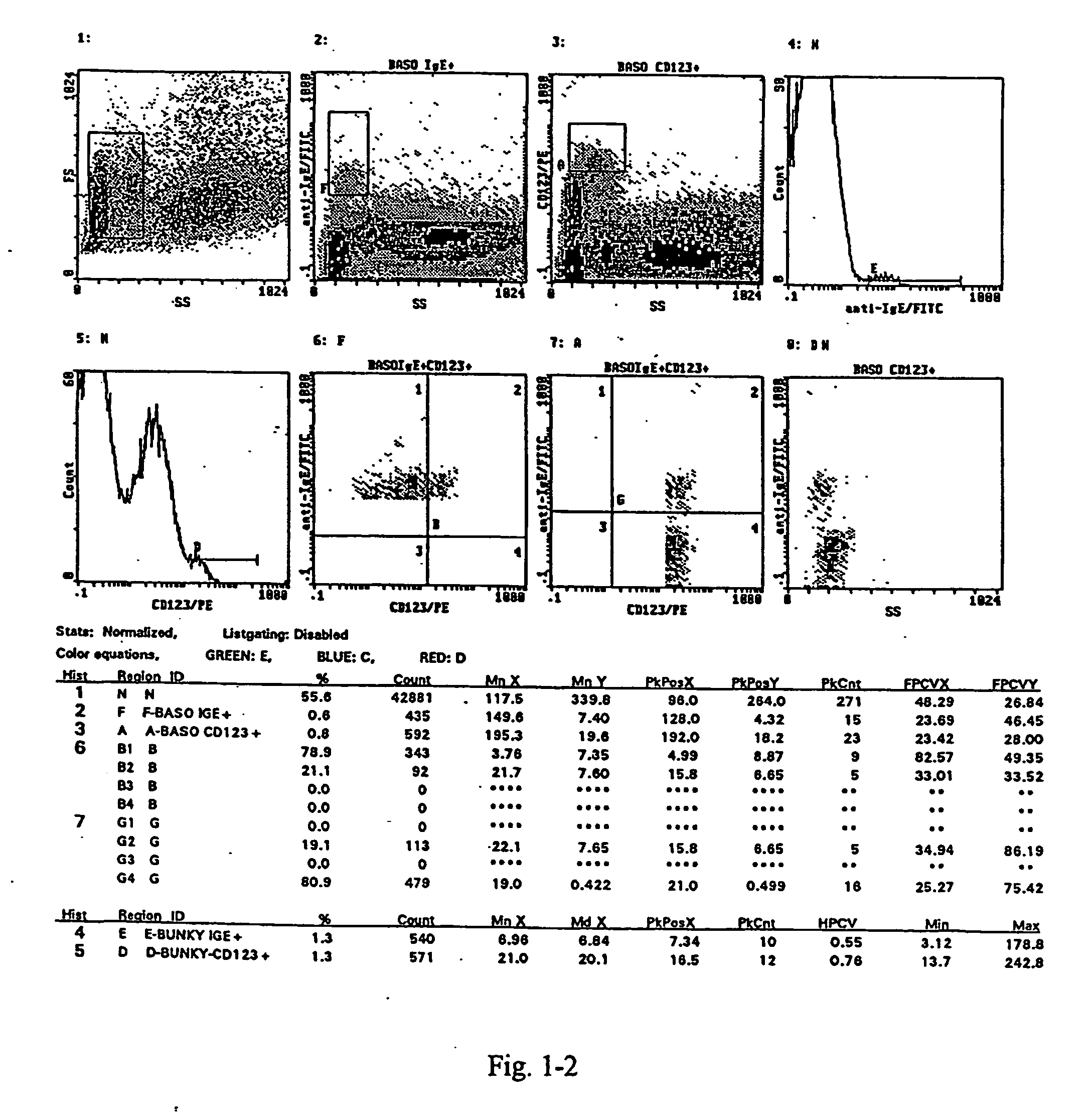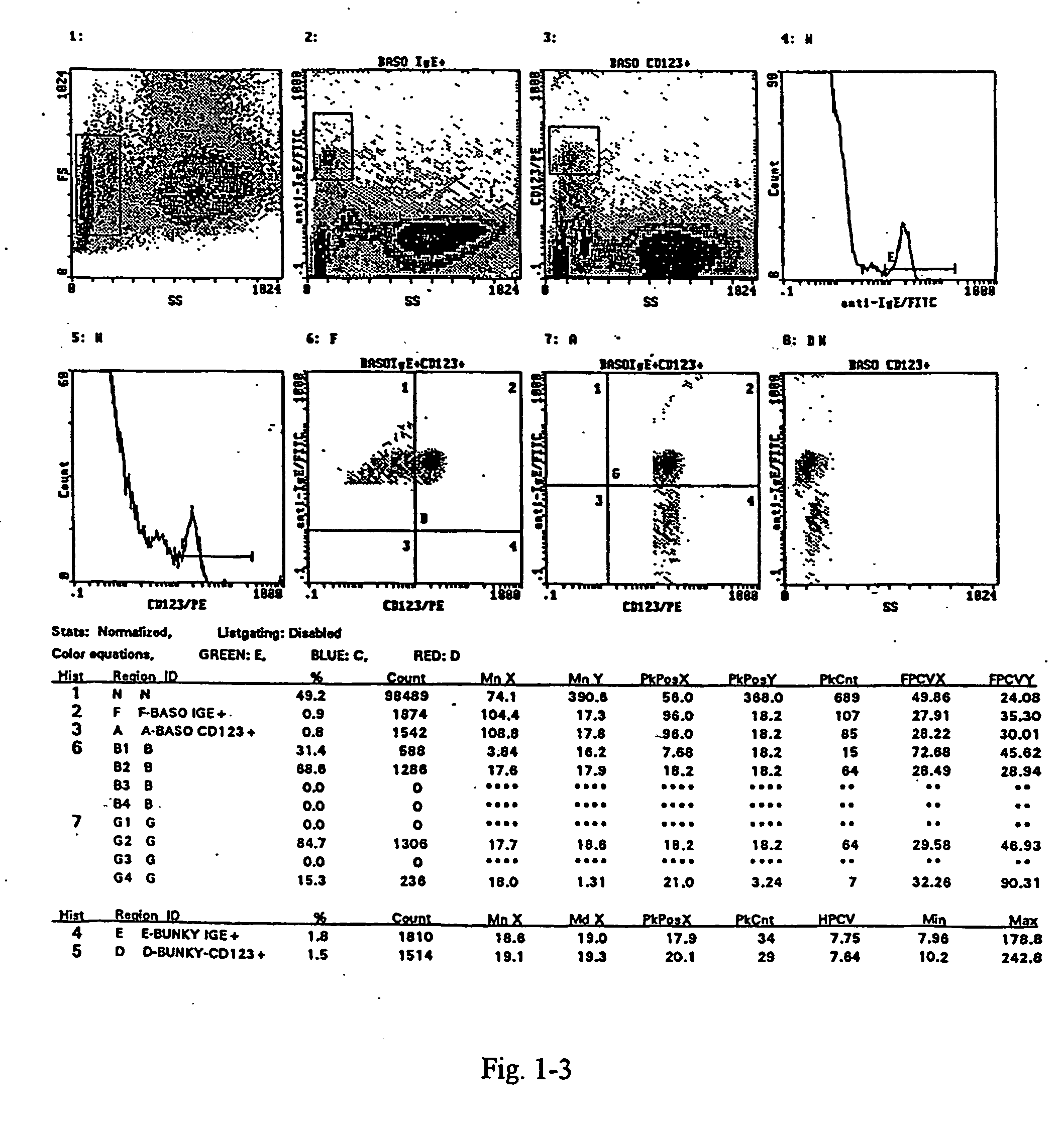Method and kit for the measurement of the activation of basophils induced by allergen to determine hypersensitivity to some substances
a technology of basophils and kits, which is applied in the field of kits for measuring the activation of basophils induced by allergens, can solve the problems of varying from skin tests, methods that are generally poorly standardized, and methods that are still far from being much widespread, and achieves the effect of low level of ig
- Summary
- Abstract
- Description
- Claims
- Application Information
AI Technical Summary
Benefits of technology
Problems solved by technology
Method used
Image
Examples
example 1
[0045] The assay is carried out from whole blood collected into heparin. For each test 100 .mu.l of the whole blood and 10 .mu.l of an IL-3 solution in PBS (buffered physiological solution) at a concentration of 0.05 .mu.g / ml is transferred by means of a pipette into a test tube. 100 .mu.l PBS is added into the test tube for the negative control, 100 .mu.l FMLP (chemotactic peptide N-formyl-L-methionyl-L-leucyl-L-phenylalanine) at a concentration of 0.433 .mu.g / ml is added into the test tube for positive control, and 100 .mu.l of the appropriately diluted allergen is added into the test tube with the sample to be tested. The samples are mixed thoroughly and incubated at 37 .quadrature.C for 30 minutes. Then the samples are transferred into an ice bath. 20 .mu.l of the monoclonal anti-CD123 antibody, labelled with PE (phycoerythrine; from Becton Dickinson), and 5 .mu.l of the monoclonal antibody anti-CD63, labelled with FITC, from Caltag, are pipetted into each test-tube. The samples...
example 2
[0046] The test is carried out from the whole blood collected into heparin For each test 100 .mu.l of the blood and 10 .mu.l of an IL-3 solution in PBS at a concentration of 0.05 .mu.g / ml is pipette into a test tube. For the negative control 100 .mu.l PBS, for the positive control 100 .mu.l FMLP at a concentration of 0.433 .mu.g / ml is added into the test tube. 100 .mu.l of the appropriately diluted allergen is added into the test tube with the sample to be tested. The samples are mixed thoroughly and incubated at 37 .quadrature.C for 30 minutes. Then the samples are transferred into an ice bath. 20 .mu.l of the monoclonal antibody anti-CD203c labelled with PE from Immunotech, and 5 .mu.l of the monoclonal antibody anti-CD63, labelled with FITC, from Caltag, are pipetted into each test-tube. The samples are mixed thoroughly and incubated in the ice bath for 15 to 20 minutes. Further processing is made at the room temperature.
[0047] The erythrocytes in the samples are lysed by additio...
example 3
[0048] The test is carried out from the whole blood collected into heparin. For each test 100 .mu.l of the blood and 10 .mu.l of an IL-3 solution in PBS at a concentration of 0.5 .mu.g / ml is pipetted into a test tube. For the negative control 100 .mu.l PBS, for the positive control 100 .mu.l FMLP at a concentration of 0.433 .mu.g / ml is added into the test tube. 100 .mu.l of the appropriately diluted allergen is added into the test tube with the sample to be tested. The samples are mixed thoroughly and incubated at 37 .quadrature.C for 30 minutes. Then the samples are transferred into an ice bath. 20 .mu.l of the monoclonal antibody anti-CD203c labelled with PE from Immunotech, and 5 .mu.l of the monoclonal antibody anti-CD63, labelled with FITC, from Caltag, are pipetted into each test-tube. The samples are mixed thoroughly and incubated in the ice bath for 15 to 20 minutes. Further processing is made at the room temperature. The erythrocytes in the samples are lysed by addition of ...
PUM
| Property | Measurement | Unit |
|---|---|---|
| Angle | aaaaa | aaaaa |
| Fraction | aaaaa | aaaaa |
| Fraction | aaaaa | aaaaa |
Abstract
Description
Claims
Application Information
 Login to View More
Login to View More - R&D
- Intellectual Property
- Life Sciences
- Materials
- Tech Scout
- Unparalleled Data Quality
- Higher Quality Content
- 60% Fewer Hallucinations
Browse by: Latest US Patents, China's latest patents, Technical Efficacy Thesaurus, Application Domain, Technology Topic, Popular Technical Reports.
© 2025 PatSnap. All rights reserved.Legal|Privacy policy|Modern Slavery Act Transparency Statement|Sitemap|About US| Contact US: help@patsnap.com



